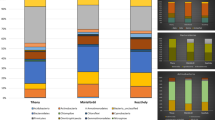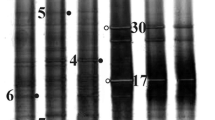Abstract
Böddi-szék is one of the shallow soda ponds located in the Kiskunság National Park, Hungary. In June 2008, immediately prior to drying out, an extensive algal bloom dominated by a green alga (Oocystis submarina Lagerheim) was observed in the extremely saline and alkaline water of the pond. The aim of the present study was to reveal the phylogenetic diversity of the bacterial communities inhabiting the water of Böddi-szék during the blooming event. Using two different selective media, altogether 110 aerobic bacterial strains were cultivated. According to the sequence analysis of the 16S rRNA gene, most of the strains belonged to alkaliphilic or alkalitolerant and moderately halophilic species of the genera Bacillus and Gracilibacillus (Firmicutes), Algoriphagus and Aquiflexum (Bacteroidetes), Alkalimonas and Halomonas (Gammaproteobacteria). Other strains were closely related to alkaliphilic and phototrophic purple non-sulfur bacteria of the genera Erythrobacter and Rhodobaca (Alphaproteobacteria). Analysis of the 16S rRNA gene-based clone library indicated that most of the total of 157 clone sequences affiliated with the anoxic phototrophic bacterial genera of Rhodobaca and Rhodobacter (Alphaproteobacteria), Ectothiorhodospira (Gammaproteobacteria) and Heliorestis (Firmicutes). Phylotypes related to the phylum Bacteroidetes formed the second most abundant group. Clones related to the mainly anaerobic and alkaliphilic bacterial genera of Anoxynatronum (Firmicutes), Spirochaeta (Spirochaetes) and Desulfonatronum (Deltaproteobacteria) were also abundant. Further clone sequences showed less than 95 % similarity values to cultivated species of the phyla Actinobacteria, Cyanobacteria, Deinococcus-Thermus, Fibrobacteres, Gemmatimonadetes and Lentisphaerae.




Similar content being viewed by others
References
Altschul SF, Madden TL, Schaeffer AA, Zhang J, Zhang Z, Miller W, Lipman DJ (1997) Gapped BLAST and PSI-BLAST: a new generation of protein database search programs. Nucleic Acids Res 25:3389–3402
Ashelford KE, Chuzhanova NA, Fry JC, Jones AJ, Weightman AJ (2005) At least 1 in 20 16S rRNA sequence records currently held in public repositories is estimated to contain substantial anomalies. Appl Environ Microbiol 71:7724–7736
Boros E, Nagy T, Cs Pigniczki, Kotymán L, Balogh KV, Vörös L (2008) The effect of aquatic birds on the nutrient load and water quality of soda pans in Hungary. Acta Zool Acad Sci H 54:207–224
Borsodi AK, Márialigeti K, Szabó G, Palatinszky M, Pollák B, Zs Kéki, Kovács AL, Schumann P, Tóth EM (2008) Bacillus aurantiacus sp. nov., a novel alkaliphilic and moderately halophilic bacterium isolated from Hungarian soda lakes. Int J Syst Evol Microbiol 58:845–851
Brettar I, Christen R, Höfle MG (2004a) Aquiflexum balticum gen. nov., a novel marine bacterium of the Cytophaga-Flavobacterium-Bacteroides group isolated from surface water of the central Baltic Sea. Int J Syst Evol Microbiol 54:2335–2341
Brettar I, Christen R, Höfle MG (2004b) Belliella baltica gen. nov., sp. nov., a novel marine bacterium of the Cytophaga-Flavobacterium-Bacteroides group isolated from surface water of the central Baltic Sea. Int J Syst Evol Microbiol 54:65–70
Bryantseva IA, Gorlenko VM, Kompantseva EI, Achenbach LA, Madigan MT (1999a) Heliorestis daurensis, gen. nov. sp. nov., an alkaliphilic rod-to-coiled-shaped phototrophic heliobacterium from a siberian soda lake. Arch Microbiol 172:167–174
Bryantseva I, Gorlenko VM, Kompantseva EI, Imhoff JF, Suling J, Mityushina L (1999b) Thiorhodospira sibirica gen. nov., sp. nov., a new alkaliphilic purple sulfur bacterium from a Siberian soda lake. Int J Syst Bacteriol 49:697–703
Csotonyi JT, Swiderski J, Stackebrandt E, Yurkov VV (2008) Novel halophilic aerobic anoxygenic phototrophs from a Canadian hypersaline spring system. Extremophiles 12:529–539
Dimitru PA, Pinkart HC, Peyton BM, Mormile MR (2008) Spatial and temporal patterns in the microbial diversity of a meromictic soda lake in Washington State. Appl Environ Microbiol 74:4877–4888
Duckworth AW, Grant WD, Jones BE, van Steenbergen R (1996) Phylogenetic diversity of soda lake alkaliphiles. FEMS Microbiol Ecol 19:181–191
Eiler A, Bertilsson SI (2004) Composition of freshwater bacterial communities associated with cyanobacterial blooms in four Swedish lakes. Environ Microbiol 6:1228–1243
Felföldi T, Somogyi B, Márialigeti K, Vörös L (2009) Characterization of photoautotrophic picoplankton assemblages in turbid, alkaline lakes of the Carpathian Basin (Central Europe). J Limnol 68:385–395
Foti MJ, Sorokin DY, Lomans B, Mussman M, Zacharova EE, Pimenov NV, Kuenen JG, Muyzer G (2007) Diversity, activity, and abundance of sulfate-reducing bacteria in saline and hypersaline soda lakes. Appl Environ Microbiol 73:2093–2100
Foti MJ, Sorokin DY, Zacharova EE, Pimenov NV, Kuenen JG, Muyzer G (2008) Bacterial diversity and activity along a salinity gradient in soda lakes of the Kulunda Steppe (Altai, Russia). Extremophiles 12:133–145
Garnova ES, Zhilina TN, Tourova TP, Lysenko AM (2003) Anoxynatronum sibiricum gen. nov., sp. nov. alkaliphilic saccharolytic anaerobe from cellulolytic community of Nizhnee Beloe (Transbaikal region). Extremophiles 7:213–220
Hiraishi A, Ueda Y (1995) Isolation and characterization of Rhodovulum strictum sp. nov. and some other purple nonsulfur bacteria from colored blooms in tidal and seawater pools. Int J Syst Bacteriol 45:319–326
Hollibaugh JT, Wong PS, Bano N, Pak SK, Prager EM, Orrego C (2001) Stratification of microbial assemblages in Mono Lake, California, and response to a mixing event. Hydrobiologia 466:45–60
Humayoun SB, Bano N, Hollibaugh JT (2003) Depth distribution of microbial diversity in Mono Lake, a meromictic soda lake in California. Appl Environ Microbiol 69:1030–1042
Jones BE, Grant WD, Duckworth AW, Owenson GG (1998) Microbial diversity of soda lakes. Extremophiles 2:191–200
Joshi AA, Kanekar PP, Kelkar AS, Shouche YS, Vani AA, Borgave SB, Sarnaik SS (2008) Cultivable bacterial diversity of alkaline Lonar Lake, India. Microb Ecol 55:163–172
Kim OS, Cho YJ, Lee K, Yoon SH, Kim M, Na H, Park SC, Jeon YS, Lee JH, Yi H, Won S, Chun J (2012) Introducing EzTaxon-e: a prokaryotic 16S rRNA gene sequence database with phylotypes that represent uncultured species. Int J Syst Evol Microbiol 62:716–721
Kimura M (1980) A simple method for estimating evolutionary rates of base substitutions through comparative studies of nucleotide sequences. J Mol Evol 16:111–120
Lane DJ (1991) 16S/23S rRNA sequencing. In: Stackebrandt E, Goodfellow M (eds) Nucleic acid techniques in bacterial systematics. Wiley, New York, pp 115–149
Ma Y, Xue Y, Grant WD, Collins NC, Duckworth AW, van Steenbergen RP, Jones BE (2004a) Alkalimonas amylolytica gen. nov., sp. nov., and Alkalimonas delamerensis gen. nov., sp. nov., novel alkaliphilic bacteria from soda lakes in China and East Africa. Extremophiles 8:193–200
Ma Y, Zhang W, Xue Y, Zhou P, Ventosa A, Grant WD (2004b) Bacterial diversity of the Inner Mongolian Baer Soda Lake as revealed by 16S rRNA gene sequence analyses. Extremophiles 8:45–51
Massol-Deya AA, Odelson DA, Hickey RF, Tiedje JM (1995) Bacterial community fingerprinting of amplified 16S and 16–23S ribosomal DNA sequences and restriction endonuclease analysis (ARDRA). In: Akkermans ADL, van Elsas JD, deBruijn FJ (eds) Molecular Microbial Ecology Manual. Kluwer Academic Publishers, Dordrecht, pp 3.3.2:1–3.3.2:8
Mesbah NM, Abou-El-Ela SH, Wiegel J (2007) Novel and unexpected prokaryotic diversity in water and sediments of the alkaline, hypersaline lakes of the Wadi An Natrun, Egypt. Microb Ecol 54:598–617
Messing J (1983) New M13 vectors for cloning. Methods Enzymol 101:20–78
Milford AD, Achenbach LA, Jung DO, Madigan MT (2000) Rhodobaca bogoriensis gen. nov. and sp. nov., an alkaliphilic purple nonsulfur bacterium from African Rift Valley soda lakes. Arch Microbiol 174:18–27
Mwirichia R, Muigai AW, Tindall B, Boga HI, Stackebrandt E (2010) Isolation and characterization of bacteria from the haloalkaline Lake Elmenteita, Kenya. Extremophiles 14:339–348
Mwirichia R, Cousin S, Muigai AW, Boga HI, Stackebrandt E (2011) Bacterial diversity in the haloalkaline Lake Elmenteita, Kenya. Curr Microbiol 62:209–221
Rees HC, Grant WD, Jones BE, Heaphy S (2004) Diversity of Kenyan soda lake alkaliphiles assessed by molecular methods. Extremophiles 8:63–71
Rusznyák A, Vladár P, Szabó G, Márialigeti K, Borsodi AK (2008) Phylogenetic and metabolic bacterial diversity of Phragmites australis periphyton communities in two Hungarian shallow soda lakes. Extremophiles 12:763–773
Saitou N, Nei M (1987) The neighbor-joining method: a new method for reconstructing phylogenetic trees. Mol Biol Evol 4:406–425
Sorokin DY, Gorlenko VM, Namsaraev BB, Namsaraev ZB, Lysenko AM, Eshinimaev BT, Khmelenina VN, Trotsenko YA, Kuenen JG (2004) Prokaryotic communities of the north-eastern Mongolian soda lakes. Hydrobiologia 522:235–248
Tamura K, Peterson D, Peterson N, Stecher G, Nei M, Kumar S (2011) MEGA5: molecular evolutionary genetics analysis using maximum likelihood, evolutionary distance, and maximum parsimony methods. Mol Biol Evol 28:2731–2739
Wani AA, Surakasi VP, Siddharth J, Raghavan RG, Patole MS, Ranade D, Shouche YS (2006) Molecular analysis of microbial diversity associated with the Lonar soda lake in India: an impact crater in a basalt area. Res Microbiol 157:928–937
Zhang W, Mao W, Xue Y, Ma Y, Zhau P (2001) Diversity of alkaliphilic bacteria in Hailer soda lakes, Inner Mongolia Autonomous Region of China. Biodivers Sci 9:44–50
Zhang W, Xue Y, Ma Y, Grant WD, Ventosa A, Zhou P (2002) Marinospirillum alkaliphilum sp. nov., a new alkaliphilic helical bacterium from Haoji soda lake in Inner Mongolia Autonomous Region of China. Extremophiles 6:33–37
Zhilina TN, Zavarzin GA, Rainey F, Kevbrin VV, Kostrikina NA, Lysenko AM (1996) Spirochaeta alkalica sp. nov., Spirochaeta africana sp. nov., and Spirochaeta asiatica sp. nov., alkaliphilic anaerobes from the continental soda lakes in Central Asia and the East African Rift. Int J Syst Bacteriol 46:305–312
Author information
Authors and Affiliations
Corresponding author
Additional information
Communicated by A. Oren.
Electronic supplementary material
Below is the link to the electronic supplementary material.
792_2013_540_MOESM1_ESM.docx
Rarefaction curve for the different ARDRA patterns of 16S rRNA gene bacterial clones originated from the water of Böddi-szék (DOCX 19 kb)
Rights and permissions
About this article
Cite this article
Borsodi, A.K., Knáb, M., Czeibert, K. et al. Planktonic bacterial community composition of an extremely shallow soda pond during a phytoplankton bloom revealed by cultivation and molecular cloning. Extremophiles 17, 575–584 (2013). https://doi.org/10.1007/s00792-013-0540-x
Received:
Accepted:
Published:
Issue Date:
DOI: https://doi.org/10.1007/s00792-013-0540-x




